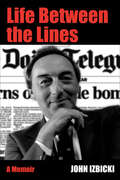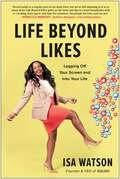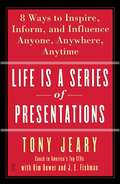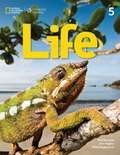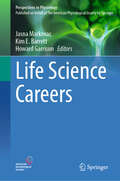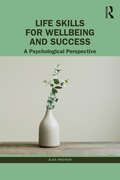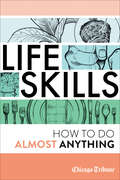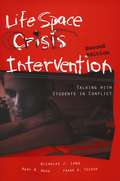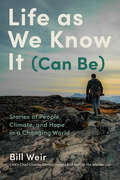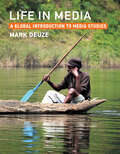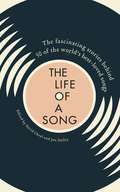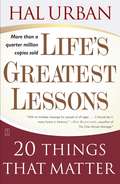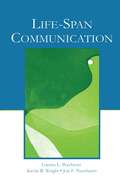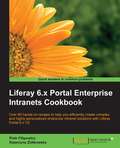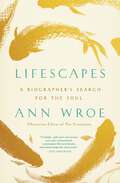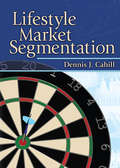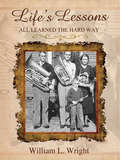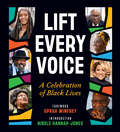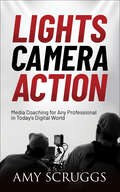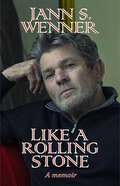- Table View
- List View
Life After Television
by George GilderPredicts that personal computers linked into a global network will soon replace television, and thereby overthrow the tyranny of mass media, renew individual power, and promote democracy worldwide. Urges American business to get on the ball with fiber optics. Reprinted from the 1990 edition published by Whittle Books. No index or bibliography.
Life Between the Lines: A Memoir
by John IzbickiThe Daily Telegraph correspondent tells his &“fascinating history, not just of newspapers, but of his personal life, fleeing Nazi Germany, as a child&” (The Independent). Berlin-born, John Izbicki lived through the horrors of Nazi persecution and, on the day after his eighth birthday, he witnessed the Kristallnacht, and the smashing of his parents&’ shop windows. On the day Germany invaded Poland and Berlin experienced its first wartime blackout, the Izbickis escaped to Holland and from there on to England. The author describes what it feels like to have been a refugee, unable to speak or understand a single word of English, and how he was persuaded by a kind policeman to change his name from Horst to John. He also leads the reader along the remarkable journey he traveled from school to university, the first of his family to enter higher education, and through his adventurous time as a commissioned army officer during two years of national service spent in Egypt and Libya. But the best part of his life was yet to come when this young refugee decided to make journalism his profession. The boy who, not that many years earlier, could speak not a word of English, became the distinguished education correspondent of the country&’s leading quality newspaper, the Daily Telegraph. After eighteen years in that responsible position, he was sent to Paris to head the Telegraph&’s office there. When he left the newspaper to join the Committee of Directors of Polytechnics, he played a leading part in transforming the country&’s polytechnics into its &“new universities.&”&“From Nazi Germany to Fleet Street—the story of a charming survivor.&” —The Guardian
Life Beyond Likes: Logging Off Your Screen and Into Your Life
by Isa WatsonWith so much of our lives lived online, we&’ve never been more connected—or disconnected from what&’s most important to us. It&’s time to let go of our curated online worlds and get beyond our need for likes. For all that we think we&’re getting out of social media, we&’re also getting duped. The perfection echo chamber oftentimes makes us feel like we&’re getting left behind. The truth is, life is messy, but curated online fabulousness makes it hard to let our true selves show, and it impedes our ability to have real, meaningful connections. Depression, anxiety, and suicide are also on the rise, and the virtual world is partially to blame, affecting our self-worth, our friendships, and the way we choose to navigate our real lives. As the founder and CEO of Squad, an app company built on connectedness, Isa Watson knows firsthand why we need to learn how to be more genuine. The digital world is her lifeblood, but it&’s also been an Achilles&’ heel: She struggled privately with some of the biggest challenges life can throw at you, while online she seemed to be living her best life—earning high-profile accolades, taking fabulous trips, and partying with the likes of many big name celebrities. It took a personal crisis to make her realize that she needed to change. In Life Beyond Likes, she gets real, sharing practical guidance on: Getting over the addiction to likes, and letting your true self shine Recognizing your own damaging habits and developing healthy ones Determining when a friendship has run its course Getting comfortable with discomfort in order to make real connections Drawing from a wealth of experiences including being the youngest published chemist in the world, working as executive in the upper echelons at JPMorgan Chase, and founding her own company, Isa helps readers better understand what constitutes success, identify what&’s really important, and achieve a balance between the curated online world and the enriching, emotionally nourishing world right in front of us.
Life Is a Series of Presentations: 8 Ways to Punch Up Your People Skills at Work, at Home, Anytime, Anywhere
by Tony Jeary Kim Dower J. E. FishmanPresentation Mastery Is the Key to Professional and Personal Success. As presentation coach to America's top CEOs, Tony Jeary has become known as Mr. Presentation . In his work with more than 500 world-class organizations in 35 countries, he has found a common denominator in every situation: Your success in life depends upon how you approach the millions of opportunities before you. And in this insightful and compelling book, Jeary reveals the eight simple secrets that you can put to work immediately to achieve dramatic results both at work and at home -- and everywhere else! Unless you're a hermit living on a mountaintop, your life largely consists of your interactions with the people around you. Whether you call them presentation skills or people skills, these eight essential practices will allow you to master any interaction, whether it involves a roomful of colleagues, a small group, or just one other person. You will learn to understand both why the eight essentials work as well as how they work, including: the single word that will convince 93 percent of your listeners every time the big question presenters consistently forget to ask themselves the 10 personality types you must be able to recognize and handle the firepower of your own Presentation Arsenal the magic behind the mnemonic I P R E S E N T. Engaging, informative, and loaded with useful anecdotes, this book will teach you easy-to-use skills that change the way you approach every situation and that will have an immediate impact on you, both professionally and personally. Because your life is a series of presentations.
Life Level 5 Student Book
by Helen Stephenson John Hughes Paul DummettThrough an exploration of real world content from National Geographic presented through stunning images, text, and video, this title helps learners strengthen their existing global connections while learning the English skills needed for communication in the 21st century.
Life Science Careers (Perspectives in Physiology)
by Jasna Markovac Kim E. Barrett Howard GarrisonThis book is written for the many Life Science PhD students who may pursue careers outside of academic research. Even though the biggest portion of students will ultimately pursue other paths, university education trains them mostly for the academic track. Students often miss information, resources, contacts, or opportunities to explore other options. In response, the editors assembled a diverse group of authors from all fields related to Life Science research. The chapters offer a peek behind the curtain of each industry and offer guidance on how to move towards such roles. Through a high level of uniformity, students will get a plethora of career stories, each providing job opportunities, job descriptions, resources, and useful contact information. The purpose of this volume is to illustrate the many excellent opportunities that are available to life science PhDs, which will still allow them to make significant contributions to science.
Life Skills for Wellbeing and Success: A Psychological Perspective
by Alka WadkarThis volume covers topics on awareness about one’s psychological health, management of emotions, mental hygiene, and wellbeing. It examines different types of thinking, reasoning, problem-solving, and strategies for building emotional intelligence. The book is a unique presentation of theories, research, and applications within important areas of psychology that will help the readers understand the aspects of self – emotional, cognitive, motivational, value orientation of self, and communication styles. This book shares insights into how to utilize our potential to fulfill our expectations from life with the help of positive psychological orientation. It will serve as an invaluable guide for readers interested to work on their emotional intelligence, mental health, and personal and group wellbeing, for gaining insight into developing cognitive, emotional, social, and behavioral aspects of self. It will also be of interest to students, scholars, and researchers in behavioral sciences, mental health, cognitive psychology, social psychology, counselling, philosophy, and wellness.
Life Skills: How to Do Almost Anything
by Chicago TribuneAn entertaining treasury of tips, hacks, and step-by-step techniques to smooth your way through the world.How do you give a good wedding toast? How do you fix a clogged drain? How do you bowl without hurting anyone? Questions like these—some highly practical, others wildly funny—make up this engaging do-it-yourself guide. Including illustrations and diagrams and compiled from the Chicago Tribune how-to column “Life Skills,” this book is filled with often-humorous instructions on performing a variety of tasks—from technical challenges to social interactions.sew a button • wrap a gift • shine your shoes • clean your keyboard • ask for a raise • give yourself a facial massage • flirt • pack for a road trip • turn down a request • teach someone to ride a bike • photograph a dog • change a tire • fix a faucet • load a moving truck • end a relationship • give a tip • choose an engagement ring • and more
Life Space Crisis Intervention: Talking with Students in Conflict
by Nicholas J. Long Mary M. Wood Frank A. FecserProvides teachers, counselors, and others who work in some capacity with youth with guidance in Life Space Crisis Intervention (LSCI), a crisis intervention strategy developed from Fritz Redl's 1959 concept of Life Space Interviewing, a form of mediation that turns a student's potentially destructive experience into a instructional and insightful experience.
Life as We Know It (Can Be): Stories of People, Climate, and Hope in a Changing World
by Bill WeirAward-winning journalist and CNN chief climate correspondent Bill Weir draws on his years of immersive travel and reporting to share the best ideas and stories of hope and positivity from the people and communities around the world who are thriving in the wake of climate change, and what we can learn from them to build a more promising future.While reporting from every state and every continent, and filming his acclaimed CNN Original Series The Wonder List, Bill Weir has spent decades telling the stories of unique people, places, cultures, and creatures on the brink of change. As the first Chief Climate Correspondent in network news, he’s immersed in the latest science and breakthroughs on the topic, while often on the frontlines of disasters, natural and manmade.In 2020, Bill began distilling these experiences into a series of Earth Day letters for his then-newborn son to read in 2050, to help him better understand the world he will have grown up in and be better prepared to embrace the future. Bill’s work and his letters were the inspiration for Life As We Know It (Can Be), which confronts the worry and wonder of climate change with messages and examples of hope for all of us on how a better future can still be written.Highlighting groundbreaking innovation in fields of clean energy, food and water sources, housing and building materials, and more, and touching on how happiness, resilience, and health and wellness factor into the topic of climate change, Bill’s stories take readers on a global journey, from one community in Florida that took on a hurricane and never lost power, to the Antarctic Peninsula where one species of penguin is showing us the key to survival, to the nuclear fusion labs where scientists are trying to build a star in a box. In these pages, we join a search for ancient wisdom and new ideas.Life As We Know It (Can Be) is a celebration of the wonders of our planet, a meditation on the human wants and needs that drive it out of balance, and an inspiration for communities to galvanize around nature and each other as the very best way to best prepare and plan for what’s next.
Life in Media: A Global Introduction to Media Studies
by Mark DeuzeA new way to teach media studies that centers students&’ lived experiences and diverse perspectives from around the world.From the intimate to the mundane, most aspects of our lives—how we learn, love, work, and play—take place in media. Taking an expansive, global perspective, this introductory textbook covers what it means to live in, rather than with, media. Mark Deuze focuses on the lived experience—how people who use smartphones, the internet, and television sets make sense of their digital environment—to investigate the broader role of media in society and everyday life. Life in Media uses relatable examples and case studies from around the world to illustrate the foundational theories, concepts, and methods of media studies. The book is structured around six core themes: how media inform and inspire our daily activities; how we live our lives in the public eye; how we make distinctions between real and fake; how we seek and express love; how we use media to effect change; how we create media and shared narratives; and how we seek to create well-being within media. By deliberately including diverse voices and radically embracing the everyday and mundane aspects of media life, this book innovates ways to teach and talk about media.Highlights diverse international voices, images, and casesUses accessible examples from everyday life to contextualize theory Offers a comprehensive, student-centered introduction to media studiesExtensively annotated bibliography offers dynamic sources for further study, including readings and documentary films
Life of a Song: The fascinating stories behind 50 of the worlds best-loved songs
by David Cheal Jan DalleyWho knew that Paul McCartney originally referred to Yesterday as 'Scrambled Eggs' because he couldn't think of any lyrics for his heart-breaking tune? Or that Patti LaBelle didn't know what 'Voulez-vous couches avec moi ce soir?' actually meant?These and countless other fascinating back stories of some of our best-known and best-loved songs fill this book, a collection of the highly successful weekly The Life of a Song columns that appear in the FT Weekend every Saturday. Each 600-word piece gives a mini-biography of a single song, from its earliest form (often a spiritual, or a jazz number), through the various covers and changes, often morphing from one genre to another, always focusing on the 'biography' of the song itself while including the many famous artists who have performed or recorded it.The selection covers a wide spectrum of the songs we all know and love - rock, pop, folk, jazz and more. Each piece is pithy, knowledgeable, entertaining, full of anecdotes and surprises. They combine deep musical knowledge with the vivid background of the performers and musicians, and of course the often intriguing social and political background against which the songs were created.
Life on Delay: USA Today Book Club
by John HendricksonA NEW YORKER BEST BOOK OF THE YEAR • USA TODAY BOOK CLUB PICK • ONE OF AUDIBLE'S BEST BIOS AND MEMOIRS OF 2023 • &“A raw, intimate look at [Hendrickson's] life with a stutter. It&’s a profoundly moving book that will reshape the way you think about people living with this condition.&”—Esquire • A candid memoir about a lifelong struggle to speak. &“Life On Delay brims with empathy and honesty . . . It moved me in ways that I haven&’t experienced before. It&’s fantastic.&”—Clint Smith, author of the #1 New York Times bestseller How the Word Is Passed&“I can&’t remember the last time I read a book that made me want to both cry and cheer so much, often at the same time.&”—Robert Kolker, best-selling author of Hidden Valley RoadIn the fall of 2019, John Hendrickson wrote a groundbreaking story for The Atlantic about Joe Biden&’s decades-long journey with stuttering, as well as his own. The article went viral, reaching readers around the world and altering the course of Hendrickson&’s life. Overnight, he was forced to publicly confront an element of himself that still caused him great pain.He soon learned he wasn&’t alone with his feelings: strangers who stutter began sending him their own personal stories, something that continues to this day. Now, in this reported memoir, Hendrickson takes us deep inside the mind and heart of a stutterer as he sets out to answer lingering questions about himself and his condition that he was often too afraid to ask.In Life on Delay, Hendrickson writes candidly about bullying, substance abuse, depression, isolation, and other issues stutterers like him face daily. He explores the intricate family dynamics surrounding his own stutter and revisits key people from his past in unguarded interviews. Readers get an over-the-shoulder view of his childhood; his career as a journalist, which once seemed impossible; and his search for a romantic partner. Along the way, Hendrickson guides us through the evolution of speech therapy, the controversial quest for a &“magic pill&” to end stuttering, and the burgeoning self-help movement within the stuttering community. Beyond his own experiences, he shares portraits of fellow stutterers who have changed his life, and he writes about a pioneering doctor who is upending the field of speech therapy.Life on Delay is an indelible account of perseverance, a soulful narrative about not giving up, and a glimpse into the process of making peace with our past and present selves.
Life's Greatest Lessons: 20 Things That Matter
by Hal UrbanLife's Greatest Lessons is a wise, wonderful book. In it, Hal Urban, a parent and an award-winning teacher, presents twenty principles that are as deeply rooted in common sense as they are in compassion. The topics, gathered from a lifetime of teaching both children and adults, span a wide range of readily understood concepts, including attitudes about money, understanding the real meaning of "success," and the importance of having fun. The book will help you find the best -- in the world, in others, and in yourself. Classic in its simplicity and enduring in its appeal, Life's Greatest Lessons helps us all rediscover that the desire to live a good life is timeless.
Life-Enriching Education: Nonviolent Communication Helps Schools Improve Performance, Reduce Conflict, and Enhance Relationships
by Riane Eisler Marshall B. RosenbergAddressing the need for a dynamic change in the formula schools use to mold their students, this groundbreaking guide provides a new approach to education that serves the lives of everyone in the learning community. By implementing the unique communication skills outlined, educators can promote cooperation and understanding and address many of the complex problems faced in the classroom. Teachers will learn new skills to increase student interest, achievement, and retention, as well as create a safe and supportive learning and working atmosphere. They are also given strategies for cultivating emotional intelligence, respect, authenticity, and empathy and are empowered to resolve conflict and prevent or defuse violence. The end result helps teachers rediscover the joy of teaching motivated students.
Life-Span Communication (Routledge Communication Series)
by Kevin B. Wright Jon F. Nussbaum Loretta L. PecchioniThis innovative text emphasizes how communicative processes develop, are maintained, and change throughout the life span. Topics covered include language skills, interpersonal conflict management, socialization, care-giving, and relationship development. Core chapters examine specific communication processes from infancy through childhood and adolescence into middle age and later life.In its exploration of the role of communication in human development, this volume:*overviews the theoretical and methodological issues related to studying communication across the life span;*discusses foundations of communication: cognitive processes and language;*examines communication in relational contexts and communication competencies;*considers communication in leisure and the media with relevance to the life-span perspective; and*presents the implications of the life-span perspective for future research. This text is intended to be used in life-span communication courses and in interpersonal communication courses with a life-span focus, at an advanced or graduate level. It may also be used in courses on family communication, aging, and language development. It will serve as a supplemental text for courses in psychology, family studies, personal relationships, linguistics, and language studies.
Liferay 6.2 Intranet Portal Development Guide
by Navin AgarwalThis book is for anyone who is interested in the Liferay Intranet Portal. This book is for both beginners and more experienced portal developers who need to create an enterprise intranet portal for their business. It will be handy for IT professionals who know the basics of how the portal technology works and need to integrate different open source technologies.
Liferay 6.x Portal Enterprise Intranets Cookbook
by Piotr Filipowicz Katarzyna ZiolkowskaIf you are a Java developer or administrator with a technical background and want to install and configure Liferay Portal as an enterprise intranet, this is the book for you. In short, reusable recipes help you realize business goals as working features in Liferay. This book will also give you useful hints on how to easily improve the default functionality of the system and its performance.
Lifescapes: A Biographer's Search for the Soul
by Thomas Nelson"A lyrical, radiant memoir." —Kirkus Reviews, Starred ReviewAnn Wroe, obituaries editor for The Economist, reflects on the art and impossibility of capturing life on the page. Through her experiences and through people she has known, studied, or merely glimpsed in windows, she movingly explores what makes a life and how that life lingers after in this breathtaking combination of poetry, memoir, and observation.'What is life?' asked the poet Shelley, and he could not come up with an answer. Scientists, too, for all their understanding of how life manifests, thrives and evolves, have still not answered that fundamental question. Yet biographers and obituarists continue to corral lives in a few columns, or a few hundred pages, aware all the time how fleeting and elusive their subject is.In this dazzlingly original blend of poetry, biography, observation, and memoir, Wroe explores the experience of trying to capture the essence of a person. Animated by her rare imagination, eye for the telling detail, and the wit, beauty and clarity of her writing, Lifescapes is a luminous, deeply personal answer to Shelley's question.
Lifestyle Market Segmentation
by Art Weinstein Dennis J. CahillThe latest marketing guide from expert Dennis Cahill-that teaches how to effectively use lifestyle segmentation for marketing strategiesLifestyle Market Segmentation gives author and marketing expert Dennis Cahill the chance to put his nearly 30 years of marketing and teaching experience to practical use-to clearly explain the process of market segmentation and its applications. This text goes beyond the obvious demographic and/or geographic categories to get at the "whys" of customer behaviors, carefully reviewing every facet, from theory to the exploration of applications. Step by step, this easy-to-understand book, written by the author of How Consumers Pick a Hotel: Strategic Segmentation and Target Marketing and other classic marketing books, walks readers through the process, giving real-life examples as illustration as it provides the tools to effectively market by lifestyle segment in today&’s competitive marketplace.Market segmentation research examines a broad range of demographic and psychographic information that can provide strategies to target both current and potential markets. This helpful guide comprehensively reveals how to gather and effectively use this crucial type of research. Lifestyle Market Segmentation consists of three main parts. The first part discusses segmentation theory and various methods for segmentation. The second part explores applications of lifestyle segmentation based on case studies. The last section focuses on ways to market products and services to the various segments discovered by the applications. This invaluable text is extensively referenced and includes several tables and figures to clarify concepts and data.Lifestyle Market Segmentation discusses in detail: the concept of market segmentation criteria for segmentation schemes types of nonlifestyle segmentation geodemographic segmentation psychographics the List of Values (LOV) guidelines for effective use of psychographics lifestyle target segments the Tribes segmentation scheme the Myers-Briggs Type Indicator life-stage segmentation illustrative real-life case studiesLifestyle Market Segmentation is an enlightening resource that is certain to be used again and again, and makes essential reading for managers, educators, and students.
Life’s Lessons: All Learned the Hard Way
by William L. WrightLife's Lessons - All Learned The Hard Way, was written to give you, the reader, several things to "think about". It matters not whether you or anyone else agrees with a single word I say herein. In fact, an awful lot of people are going to disagree with this whole concept for a wide variety of reasons, most of them being very selfish. You are about to learn some totally different ideas that will be the exact opposite of all the old myths about sex, and life in general. You also be shown some new ideas other than those that the world has lived with since the beginning of religion. FOR MATURE AUDIENCES ONLY!
Lift Every Voice: A Celebration of Black Lives
by Oprah Winfrey Nikole Hannah-Jones&“When we lift every voice, we forge a deep and enduring connection to the past—and carve a tunnel of hope to a brighter future for us all.&” -Oprah Winfrey &“This book, above all else, is a reminder of where we have been and the debt we owe to those who came before. These Americans have not passed the torch, but are clasping it with us, urging us to continue the work alongside them,&”-Nikole Hannah-Jones More than 50 elders share their remarkable experiences of being Black in America in a collection of powerful photographs and interviews For so long, too many stories that reveal what it means and feels like to be Black in America have been overlooked outside Black communities. After these long years of racial reckonings and nascent awakenings, Lift Every Voice presents interviews with the oldest generation of Black Americans about their lives, their experiences, and the wisdom that can carry all of us to a better future. The 54 fascinating individuals—civil rights activists, hometown heroes, celebrities, and many others—include: • Andre de Shields, an actor, director, and choreographer who discusses the essential values and lessons his parents taught him • Clarice Freeman, an educator and community leader in Houston, Texas who speaks about how to live a long and fulfilling life • Fred Gray, a civil rights lawyer who represented Rosa Parks and Claudette Colvin, also featured in the book, against disorderly conduct charges for their refusal to give up their bus seats to white passengers • Patti LaBelle a singer/songwriter who shares her thoughts on aging and her career as an internationally celebrated powerhouse singer • Faye Wattleton, a reproductive rights activist and the first African American and youngest president of Planned Parenthood who recounts her experience as a nurse and midwife in the 1960s The insightful interviews were conducted by a brilliant team, many of whom are rising Black journalists from historically Black colleges and universities, and the portraits were shot by a talented group of next generation Black photographers. Lift Every Voice is named after the James Weldon Johnson poem and hymn "Lift Every Voice and Sing," which is often referred to as the "Black national anthem." Lift Every Voice is both a testament to the strength of the elders&’ stories and a triumphant beginning for a new generation of Black journalists and photographers.
Lightning Transients and Protection for Renewable Energy System
by Li Zhang Xiao Zhong Qiuqin Sun Feng Bin Zhi ZhengThis book is dedicated to lightning transients and protection for renewable energy systems, including both wind and solar energy. In addition to the formation mechanism of lightning transients, the practical engineering application has also been addressed. This book is comprehensive and covers the methodology of electromagnetic transient modelling, electromagnetic coupling for PV system, lightning protection design, testing and evaluation. This book is particularly suitable for readers interested in lightning phenomena and renewable energy systems. It would benefit researchers, engineers and graduate students in the fields of electrical engineering, renewable energy, computational electromagnetism, etc.
Lights, Camera, Action: Media Coaching for Any Professional in Today's Digital World
by Amy ScruggsOn-camera insecurities and fears are common for many professionals and can keep them from growing their confidence and their business through the power of the media. Lights, Camera, Action gives practical advice and techniques to help achieve on-camera and communication skills to be a leader in today’s virtual world. After completing Lights, Camera, Action, readers will know how to deliver a concise message and be confident and ready for the various media platforms including Network TV interviews, podcasts and video marketing. They will also be ready to stand out in their virtual meetings with their introduction and messaging skills. Readers will be ready to utilize media opportunities for growth and visibility for their business of any industry.
Like a Rolling Stone: A Memoir
by Jann S. WennerIn this New York Times bestseller, Rolling Stone founder, co-editor, and publisher Jann Wenner offers a "touchingly honest" and "wonderfully deep" memoir from the beating heart of classic rock and roll (Bruce Springsteen). Jann Wenner has been called by his peers &“the greatest editor of his generation.&” His deeply personal memoir vividly describes and brings you inside the music, the politics, and the lifestyle of a generation, an epoch of cultural change that swept America and beyond. The age of rock and roll in an era of consequence, what will be considered one of the great watersheds in modern history. Wenner writes with the clarity of a journalist and an essayist. He takes us into the life and work of Bob Dylan, John Lennon, Mick Jagger, Bono, and Bruce Springsteen, to name a few. He was instrumental in the careers of Hunter S. Thompson, Tom Wolfe, and Annie Leibovitz. His journey took him to the Oval Office with his legendary interviews with Bill Clinton and Barack Obama, leaders to whom Rolling Stone gave its historic, full-throated backing. From Jerry Garcia to the Dalai Lama, Aretha Franklin to Greta Thunberg, the people Wenner chose to be seen and heard in the pages of Rolling Stone tried to change American culture, values, and morality.Like a Rolling Stone is a beautifully written portrait of one man&’s life, and the life of his generation.

